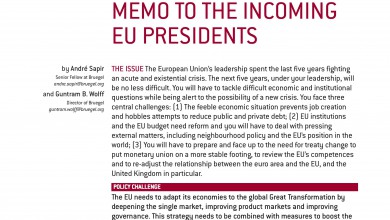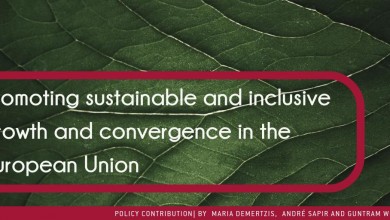Piece was first published on Internationale Politik Quarterly. The drive to change the EU’s fiscal rules has fizzled out, an agreement before the June 2024 European elections is unlikely. However, Europe cannot ignore its structural weaknesses forever.
With interest rates having risen rapidly in recent months, the question of Europe’s debt sustainability as well as its fiscal policy and architecture is returning to the forefront. Overall, the situation is not particularly concerning, especially compared to the United States or to the United Kingdom. The eurozone has lower debt-to-GDP ratio and lower planned fiscal deficits for the years ahead.
Yet, the fiscal architecture remains in flux. For the last few years, European finance ministers have been agonizing over reforming Europe’s fiscal rules and in particular the Stability and Growth Pact. The rules focusing on keeping the fiscal deficit at 3 percent of GDP, proscribing a 60 percent debt-to-GDP ratio, and allowing a 0.5 percent structural adjustment balance have been either hollowed out by ad hoc exceptions or suspended altogether during crises.
When the government of Olaf Scholz took office in Germany in late 2021, it appeared that there was finally a chance to improve the framework that governs European public finances. The consensus amongst economists had shifted in favor of a new set of rules rooted in debt sustainability analysis and in an expenditure benchmark. The hope was that such a new set of rules would be simpler, more transparent, and less procyclical than the current one. Some were also hoping that a reform would allow the protection of public investment in climate and energy transition from budget consolidation.
Little Progress
A year into the negotiations and with the June 2024 European Parliament elections looming, one must acknowledge that the EU finance ministers have made little progress. Christian Lindner, Germany’s finance minister, leader of the pro-business Free Democrats (FDP), and self-described “friendly hawk,” is insisting on a nominal annual debt reduction benchmark for all EU countries. France and Italy are disengaged and seem perfectly able to live with the current set of rules, because they know they can game the system when necessary. Spain and the Netherlands, which were the real driving force behind the negotiations, are now both held back by domestic political uncertainty.
The reality is that the compromise rules currently being discussed miss the initially stated objectives to a significant degree: They are not simpler, they are probably not even less procyclical, and they are certainly not protecting public investment in Europe’s energy transition. As of now, it appears unlikely that new rules will be agreed before the forthcoming European elections. This raises important question for Europe’s fiscal policy.
Clear Guidance Needed
In the short-term, it may exacerbate the perception that Europe has lost an important fiscal anchor given the general skepticism toward the old framework and the inability to agree to a new one. This will pose real challenges to the European Commission as it assesses current budgetary plans and makes policy recommendations to the member states. Given the still high inflation rates, the European Commission and the European Council should ensure that national budgets for 2024 do not see larger structural primary deficits. Even for Italy, despite current fiscal slippage, that yardstick should enable declining debt-to-GDP ratio in the coming years.
Next year, in the absence of new legislation, the European Commission will have to provide clarity and predictability while member states need to come to an understanding on which rules to apply. Instead of full discretion and arbitrary decisions, some clear guidance needs to be provided.
In 2015, then-Commission President Jean-Claude Juncker introduced a “flexibility clause” to account for structural reforms and investment and greatly helped introduce a less dogmatic and procyclical application of the rules. The macroeconomic situation is different today and while fiscal consolidation is necessary, EU member states need to undertake major public investment to ensure that National Energy Transition Plans and their emissions reduction targets under the Paris Climate Agreement are met. The commission needs to ensure consistency between fiscal and climate sustainability.
A Fiscal Grand Bargain
Last but not least, Europe needs to reconsider its fiscal architecture in general. The fiscal rules, the future size of the EU budget, its sources, composition, and the EU’s long-term ability to borrow are all inextricably linked and can hardly be separated. As global challenges mount, the question of EU resources to provide European public goods is becoming central.
The EU needs to agree a fiscal grand bargain to meet its economic challenges (financing research and industrial policy), its climate challenge (achieving decarbonization), its political challenges (safeguarding European unity), and its geopolitical ambition (enlarging the EU and stabilizing the neighborhood) while enhancing its security (ensuring greater defensive strength). These common goods will require large public resources that can only be summoned if Europe completes the “Hamiltonian” steps it initiated in response to the euro crisis and accelerated with its response to the COVID-19 pandemic.
The EU needs greater resources of its own—a limited but permanent capacity to borrow to fund growth-enhancing European public goods as well as a reformed EU budget with greater focus on growth. Tighter national fiscal rules could then be introduced as a counterpart to the greater role Brussels would play in providing highly necessary public goods across the EU. Until then, the EU will have to continue muddling through and failing forward. It has some experience in doing so, but it cannot escape the structural fiscal challenges it has to address.


